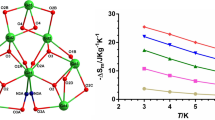Summary
The magnetic susceptibility of MoO(OH)3 or [MoOF5]2− in HF has been measured as a function of acid concentration. In very dilute acid the solutions are diamagnetic. The anionic complexes K4[Mo2O4F6] · 2H2O, K3[Mo2O4F5], Cs4[Mo2O4F6], Cs2[Mo2O4F4], (bipyH)2[Mo2O4F4] and (phenH)2[Mo2O4F4] were prepared by adding fluoride to solutions of MoO(OH)3 in dilute HF. The bipyridyl and phenanthroline compounds are converted to the nonelectrolytes [Mo2O4(bipy)2F2] and [Mo2O4(phen)2F2], respectively, on digesting with water or heating. These complexes are also obtained by adding the respective diimines to solutions of K2[MoOF5]. All the complexes are very weakly paramagnetic. The i.r. and the electronic spectra of the compounds show the characteristic features of complexes containing the Mo2O +24 moiety.
Similar content being viewed by others
References
M. C. Chakravorti and S. C. Pandit,J. Coord. Chem.5, 85 (1976).
D. Grandjean and R. Weiss,C. R. Senac. Acad. Sci. Paris, 263 C, 58 (1966).
D. Grandjean and R. Weiss,Bull. Soc. Chim. Fr., 3040 (1967); 3050 (1967).
R. Kergoat and J. E. Guerchais,Bull. Soc. Chim. Fr., 1746 (1972).
R. Mattes and G. Lux,Angew. Chem., 86, 598 (1974).
R. Mattes, K. Mennemann, H. Rieskamp and H. Brockmeyer,J. Less Common Metals, 76, 199 (1980).
W. G. Palmer,Experimental Inorganic Chemistry, The University Press, Cambridge (1954), p. 406.
M. C. Chakravorti and S. C. Pandit,Inorg. Synth., 21, (in press).
A. I. Vogel,A Text Book of Quantitative Inorganic Analysis, The English Language Book Society and Longman (1978), p. 472.
M. C. Chakravorti and S. C. Pandit,J. Inorg. Nucl. Chem., 36, 2265 (1974).
M. C. Chakravorti and S. C. Pandit,J. Inorg. Nucl. Chem., 35, 3644 (1973).
J. Lewis and R. G. Wilkins,Modern Coordination Chemistry, Interscience Publishers Inc., New York (1960), p. 403.
Reactions in more dilute HF medium did not give any pure compound.
L. Sacconi and R. Cini,J. Am. Chem. Soc., 76, 4239 (1954).
E. I. Stiefel,Progress in Inorganic Chemistry, Ed. S. P. Lippard, Interscience, vol. 22 (1977), p. 85.
R. J. H. Clark,J. Chem. Soc., 1377 (1963).
N. Vutelic and C. Djordjevic,J. Chem. Soc., Dalton Trans., 1137 (1973).
Ref. No. 15, p. 83.
I. W. Boyd, I. G. Dance, A. E. Landers and A. G. Wedd,Inorg. Chem., 18, 1875 (1979).
Author information
Authors and Affiliations
Rights and permissions
About this article
Cite this article
Chakravorti, M.C., Bera, A.K. Binuclear oxofluorocomplexes of molybdenum(V). Transition Met Chem 8, 83–86 (1983). https://doi.org/10.1007/BF01036085
Received:
Issue Date:
DOI: https://doi.org/10.1007/BF01036085




